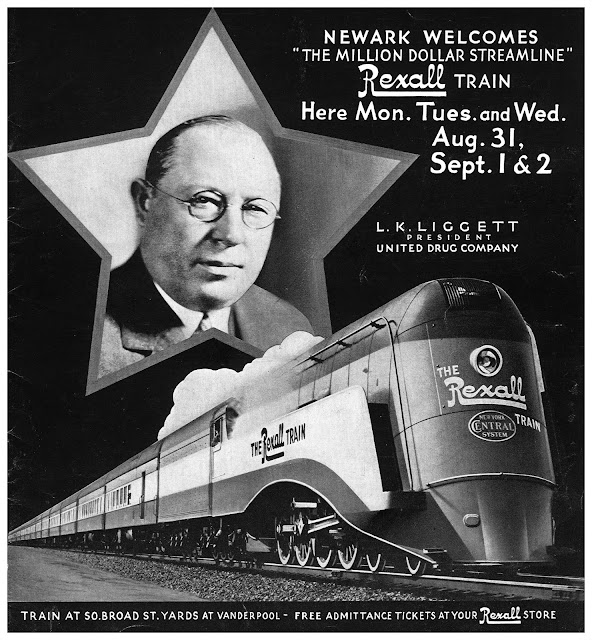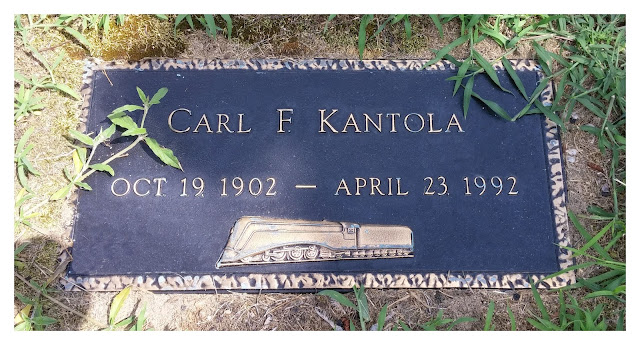Rexall
Man! Talk about marketing!
I found another YouTube video concerning the Rexall Train in addition to the one in Miningman’s post. The music isn’t exactly 1930’s but it’s impressive just the same.
Remember when Rexall affiliated pharmacies were all over the place? I do!
And didn’t “Classic Trains” do a Rexall Train article within the past year?

I think the diaphragm is foldable just like a door. I am not a big fan of Commodore Vanderbilt #5344 and the Rexall Train engine #2873, but I do wish NYC kept the streamlining of #2873 a bit longer. The Rexall Train had all cars equipped with full-width diaphragms, it seems that even the gap between the tender and the first car was enclosed by the diaphragm…
As I recall, it’s just an arrangement like cab curtains painted to match the train. (Wasn’t this covered [no pun intended] in the recent article on the Rexall train? – I think the issue of ‘full-width diaphragms’ at the tender was covered too.)
Perhaps the most fascinating thing about this is that according to Mr Liggett himself, this train was not originally intended for ‘public’ display – it was a morale-booster for all the local Rexall personnel suffering in Depression conditions, in case you were wondering why the ‘exhibits’ were . Of course, once the demand was ‘seen to be present’ the arrangements were made to establish public tours, and the statistics claimed in the annual report that year indicate that somewhere more than 2.7 million people went through the train, which is a stupendous number if it represents even an estimated number who ‘could have’ walked through while there were waiting lines visible.
And all for free, apparently. Yes, it proved a wonderful thing. Perhaps we’ll have a similar story someday for the Hadacol train (cue Mike!)
And now Rexall as a retailer no longer exists in the USA, but in name it does exist in Canuckistan.
Yes, Rexall and Liggett’s were well-known names many years ago. When I went up to Cahrlotte to see my orthodontist, I would eat lunch at the Liggett’s at the intersection of Tryon and Trade, and take a Greyhound bus the fifty miles back home. I jerked soda for about a month in the Liggett’s in downtown Baton Rouge the summer before my last year on high schoool (I went home by train to Charlotte, and then hitchhiked the rest of the way home)…
Believe it or not it was the Summer 2017 issue devoted to “Special Trains”. Tempus fugit. [:S]
Thanks Becky, I thought I remembered correctly.
But NOT that it was almost three years ago! Mamma mia…
Well, time does fly when you’re havin’ fun!
More to the refueling scene than meets the eye.
We see in a nutshell the value of using oil fuel in this touring locomotive nearly right away – no coal trucks with separate loaders, no complicated and dirty ashpan cleaning. But we also see something different, something I didn’t know – the kind of oil being burned in that locomotive.
Esso was of course Standard Oil of New Jersey, and their tradename for home heating oil – Essoheat, as on the truck – was only about three years old. They’d go on to renew it twice – in 1953 and 1973 – and it was allowed to lapse in 1994.
Oddly enough, I lived in a house with oil heat until the mid-Sixties, in neighborhoods with houses that had similar furnaces, and don’t ever remember seeing a tank with that slogan; we were loyal Esso gas consumers, too.
Now, Kantola in this reference
https://nycshs.files.wordpress.com/2014/07/pages-from-1981q3.pdf
(which I should have remembered specifically contains first-hand mention that the original Mercury was a Cleveland-Detroit train via Toledo) specifically says the locomotive was converted to burn “Western railroad” fuel, which would have been the equivalent of #5 if not in fact Bunker C heavy oil, but unless there were large tank trucks for ‘normal’ delivery of that kind of oil painted to advertise Esso’s branded product, it would certainly more than suggest that the burner and its feed systems happily ran (and made steam) on what was essentially #2 gas oil. This was the common fuel, probably easily delivered in any locale the train visited in the East, but it also seems likely that the burner and feed systems would be compatible with the heavier Western fuel – something we were repeatedly told was difficult to manage when designing oil conversions of large coal-burning locomotives.




